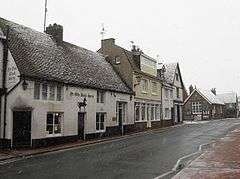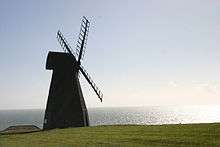Rottingdean
| Rottingdean Coastal | |
|---|---|
 Ye Olde Black Horse, High Street | |
 Rottingdean Coastal Rottingdean Coastal shown within East Sussex | |
| Population | 13,651 (2011.Ward)[1] |
| OS grid reference | TQ375025 |
| Unitary authority | |
| Ceremonial county | |
| Region | |
| Country | England |
| Sovereign state | United Kingdom |
| Post town | Brighton |
| Postcode district | BN2, BN51 |
| Dialling code | 01273 |
| Police | Sussex |
| Fire | East Sussex |
| Ambulance | South East Coast |
| EU Parliament | South East England |
| UK Parliament | |
Rottingdean is a coastal village next to the town of Brighton and within the city of Brighton and Hove, in East Sussex, on the south coast of England. It borders the villages of Saltdean, Ovingdean and Woodingdean, and has a historic centre, often the subject of picture postcards.
Name
The name is Old English for valley of the people associated with Rōta (a male personal name). Rota was probably the leader of a band of Saxons who invaded the region in 450–500 AD and replaced the existing Romano-British inhabitants. The first recorded mention is in the Domesday Book (Rotingeden, 1086). Other variations to be found in ancient charters include Ruttingedene (1272), Rottyngden (1315) and Rottendeane (1673).[2]
Rottingdean is in a dry valley whose sides in the upper reaches are quite steep, and this valley comes right down to the English Channel coast. The name was contrasted unflatteringly with Goodwood (another place in Sussex) in a national 1970s advertising campaign for wood preserver.
History

Rottingdean has about 3,200 inhabitants [3]. For most of its history it was a farming community, but from the late 18th century it attracted leisured visitors wanting a genteel alternative to raffish Brighton, among them some names famous in English cultural life. Some, in the late 19th century, notably the painter Sir Edward Burne-Jones and his nephew Rudyard Kipling, made it their home. Kipling's old house adjacent to Kipling Gardens is still standing, and the former house of the painter Sir William Nicholson is currently open to the public as a library and museum. When farming collapsed in the 1920s, much of the farmland became available for building, and Rottingdean increased significantly in population, but especially in the area known as Saltdean. A large number of smallholdings appeared in the detached part of the parish called Woodingdean.
In the summer of 1377 French pirates raided Rottingdean. The raiders probably intended to pillage the nearby Lewes priory. The raiders were detected as they landed, and a portion of the village's inhabitants retreated into the church's Saxon-built tower. The pirates were unable to take the tower and set it on fire; over a hundred people are thought to have died in the blaze. The next day the pirates were met by a force led by the Lewes Prior. During the action, two knights, Sir John Fallisle, Thomas Chinie and the prior were captured. The pirates were, however, driven to depart, with the three men later being ransomed.
Rottingdean is also notable for the black wooden windmill on the hill on its western side. Nicholson made a woodcut that was used as the logo of the publisher William Heinemann; this is often said to have been a depiction of Rottingdean mill, but a glance at both will show that this is untrue. The Rottingdean Preservation Society and its earlier incarnations have been responsible for maintaining the windmill since 1923. It was successful in getting a Heritage Lottery Fund Grant of £41,800 which together with funding from the society has ensured that the windmill remains a remarkable Grade 1 listed attraction in the 21st century. The hill is a local nature reserve. It was also well known for sport, having a cricket club founded in 1758 and having been a centre of fox hunting, especially in the second half of the 19th century.
Rottingdean Cricket Club has been in existence since 1758 and is still situated inside the village on Falmer Road. They play in the Sussex county league division 4, and they are currently captained by Jack Cox, the former holder of youngest century maker in the club and who last season took 9-24. Jack took over as captain from Michael Smith, who he injured after losing an aerial battle in a game of football to Michael during a warm up to one of the early games of the league season. Many think this was a deliberate act of mutiny after conspiring with the Ledden's, however there is no evidence to support this theory.
Parish church

Its most historic other building is its probably 13th-century church of St Margaret, built of flint and having a short spire with a cap. An almost exact replica has been built at the Forest Lawn Memorial Park, Glendale, California. The Rottingdean church features stained glass by Edward Burne-Jones, whose ashes are buried in the churchyard. Other modestly well-known burials include those of the Victorian novelist William Black, Burne-Jones's granddaughter the author Angela Thirkell, and the 1920s music hall star G. H. Elliott, known professionally as "The Chocolate-Coloured Coon". Here is also the grave of the last "squire" of Rottingdean, Steyning Beard, who died in 1909; much of his land was ultimately sold off to pay his debts.
The famous blues guitarist Gary Moore is buried at the church after his death in February 2011.
Residents
Most of these well-known people were not local, and had settled in or retired to Rottingdean. The village also had home-grown talent of significance, notably the Copper Family who maintained a long tradition of English folk song, performing for the collector Kate Lee as early as 1892. Its best-known member was Bob Copper (1915–2004), also known as a writer. The Rottingdean Preservation Society recognised their importance in the village and erected a plaque in 2010 at 1 Challoner's Cottages, partly funded from its own resources but complemented by a donation from the English Folk Dancing Society.
The first garage for motor cars was run by Charles Thomas, a former pupil of York Place School in Brighton, in the early years of the 20th century. In about 1902 Charles met the American financier Charles Glidden, and the two men embarked together on a round trip of the world, visiting many countries and cities – this was the start of the famous Glidden Tour. It is thought that Charles Thomas also worked on a machine to achieve perpetual motion, and kept one running in his basement for many months.
Most histories of Rottingdean mention that its inhabitants were involved in smuggling when that was especially profitable, mainly in the 18th century. It is impossible to verify all the local stories, or believe all the claims about secret passages under the village, but it is persistently rumoured that the 18th century vicar Dr Thomas Hooker was deeply implicated. The other face of Hooker was his devotion to education. He opened schools in the village both for the well-off (which developed eventually into the former St. Aubyns School Preparatory School) and for the local children.
World War I veteran Henry Allingham was a resident of St Dunstan's. Allingham was the oldest man in the world and the last founder member of the RAF when he died in July 2009.
Civil status and former extent of the area
The parish became part of county borough of Brighton in 1928.[4] It recently regained an independent parish council, the only one in what is now the city of Brighton and Hove. Within the parish lies the deserted hamlet of Balsdean.[5] The adjacent village of Woodingdean was formerly (until 1933) part of Rottingdean parish. Also formerly in the parish were most of the district of what is now Saltdean, Roedean School, an independent school for girls, and the Blind Veterans UK Centre, a rehabilitation centre for blinded ex-Service personnel.
Popular culture
Rottingdean plays an important role in the final act of C. J. Sansom's alternate history novel Dominion.
See also
References
- Carder, Tim (1991) The encyclopaedia of Brighton. Lewes: East Sussex County Council (1991).
- Coates, Richard (2010) A history of Rottingdean and Ovingdean through their place-names. Nottingham: English Place-Name Society.
- Copper, Bob (1976) Early to rise. London: Heinemann (1976).
- Heater, Derek (1993) The remarkable history of Rottingdean. Brighton: Dyke Publications.
- Rottingdean Preservation Society annual reports and unpublished archives.
- Green, Howard (1973) Guide to the Battlefields of Britain & Ireland London: Constable and Company, Ltd
- ↑ "Brighton and Hove ward population 2011". Retrieved 13 October 2015.
- ↑ http://www.rggj.net/Rottingdean/pc1.htm
- ↑ https://www.nomisweb.co.uk/reports/localarea?compare=1170212032 "nomis Local Area Report" census 2011
- ↑ "Vision of Britain" website article
- ↑ Carder, Tim. "Balsdean". My Brighton and Hove; Roedean and Rottingdean. Retrieved 29 September 2011.
External links
| Wikimedia Commons has media related to Category:Rottingdean. |